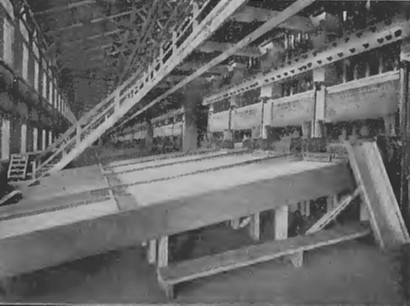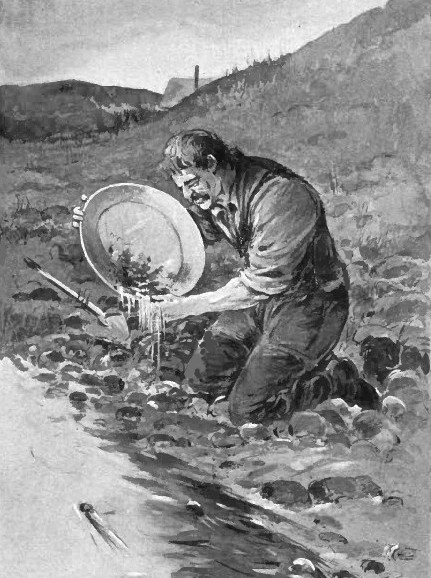There are few men on the Pacific Slope better known in mining circles than Archie Borland. Mr. Borland came from Ireland a mere boy, with all his capital invested in good muscle and a clear head. He settled down on a farm in a small place a few miles below Albany, New York, and worked away until the mining and gold rush fever swept over the land in 1849. The epidemic soon made its way up the Hudson, and he was among its first victims. He heard of the wealth that was being picked up loose all over the soil of California, and desired to do some of the picking himself. But it was a long journey to California much longer than now, and took 'a great deal of money to get there. Not prepared to start at once, he immediately began to save up his earnings, with the hope of gathering enough in a short time to pay his passage-money. Ten dollars a month was good wages on a farm in those days, and men seldom received over twelve, so that saving was slow work. It was not till early in 1852 that he was ready to start, and he took passage in one of the steamships that were running to California, and landed without accident in San Francisco. "I made up my mind to two things at the start," said he; "not to work for wages any longer than I could help, but to go in for myself; and then, never to take a partner." This plan served him well.
With nothing but a frying-pan, tin cup, pick and necessary tools, with a small supply of provisions, he went, upon reaching California, into Nevada County, and began work in the mines at four dollars per day. Working there, often in water up to his waist, at the hardest kind of labor, with the plainest of food of his own cooking, he carefully laid by the greater part of his wages, intending some day to own the mine he was working. But the mines did not prove profitable enough, and as long as he received his four dollars a day he kept to work, not deeming it a profitable investment. After some months' labor he went to Grass Valley district. Here he was able, in a short time, to buy, in a small way, into some claims, and made some money.
For several years he continued at this, growing a little richer every year till 1858, when the Frazier River gold rush began. Parties of miners were going there every day, and wild rumors of their tremendous success came back. The ground was believed to be covered with gold, and Mr. Borland caught the fever with the rest, and sold out in Grass Valley and went. The steamer on which he took passage made her way several hundred miles up the river, and the men got ready to pick up a little of the loose gold. But there was little or none to pick up. The expedition proved a disastrous failure, and the young miner soon found that he had sold out a good thing to take his chances in a sinking ship.
Reaching Grass Valley again in 1859, with just money enough left to buy a small interest in the old gold quartz mines, he set about retrieving his fortune. One of his speculations, after getting a little on his feet again, was the buying of the Rock Tunnel, which had been opened two thousand eight hundred feet. In 1863, some speculations went wrong; a vein was not as wide or as valuable as expected, and what money Archie Borland had saved disappeared like snow in the sun. Everything went with a crash, and after eleven years of hard work he was once more reduced to working for wages. "The great thing," said he," was never to quit. Stick to it. Never let go your hold, and you are bound to catch something." With precious few dollars left to operate with, he bought a mule, and once more wore a tin cup in his belt and a frying-pan strapped to his blankets. With a small party of men, bound upon the same errand, he mounted his mule and started across the hills for Idaho. They had eighteen mules in the party, packed with provisions. There was not a house on the way, and he rode that mule nine hundred miles, going" from one mining camp to another, but always in the direction of Idaho. After a long and painful journey he reached Idaho, and went to work. By diligent labor he soon owned shares in some of the mines there. By 1866 he had accumulated fifteen thousand dollars, which he had not in checks, or drafts, or bits of paper, but in gold dust, done up in bags. With his stock of gold dust, Mr. Borland determined to return to California, which he considered his proper field, although he had prospered in Idaho. Wells, Fargo & Co. had then an established express line into Idaho, and he went to them to learn what it would cost to transport his dust to San Francisco.
He was told one dollar and twenty-five cents for every one hundred dollars worth, and even at hat price he must run his own risk. He thought, however, that if he had to run his own risk he might as well save the express charges, and transport it himself, for he knew that in such a case nobody would get his gold without fighting for it. The road at that time was infested with "road agents' and the journey was a dangerous one. But he bought some mules, a big navy revolver and a supply of provisions, and started. It was along and lonely journey. But after six nights of hard riding he landed his gold dust safely in San Francisco. Then he bought into Comstock and other mines, and made money rapidly. There were no mining stocks in those days, but a "foot" of surface in length on the vein was the equivalent of a share of stock. One of his first successful speculations on a large scale was in the Savage mine. In July, 1866, he bought five feet of the Savage, at one thousand one hundred dollars per foot. During the first month that he owned it he drew fifty dollars per foot dividend. The second month the dividend rose to seventy-five dollars; then it took another rise, and reached one hundred dollars a foot dividend every month.
In the following year, 1867, the value went up tremendously. Early in the year it was worth two thousand dollars a foot, and from this it rose steadily to two thousand five hundred, three thousand, four thousand, and five thousand dollars a foot. At this price he sold his five feet for twenty-five thousand dollars; having received more than his original investment in monthly dividends before selling. Other stocks that he had went up, and his fortune gradually increased, until from twenty five thousand dollars it went gradually to fifty thousand, seventy-five thousand, and four hundred thousand dollars. In 1869, he bought largely in the Comstock mines, and up to 1872 he had no competitor in his gigantic operations. Then Jones and Heyward came up, and, as he says, he had to keep his eyes open from that time on, "for I had to compete against men with millions," he said, "and who knew how to use them. I went into Crown Point shares, and got singed. But that was nothing; there's ups and downs in any business." At one time his dividends from California and Consolidated Virginia amounted to forty thousand dollars a month.
"The best winning speculations I ever made, "he said," were from 1872 to 1874. I made a heap of money in that time, and I needed it to carry me through my worst losses in 1878. But I got through, and am still afloat. In 1872 I bought five hundred shares of 'Central' for less than five thousand dollars. This mine was soon afterward cut up and consolidated with California, and the redistribution gave me one thousand two hundred I and fifty shares. I never paid an assessment on it, for none were called, and in a short time the stock went up to seven hundred and forty dollars a share, when I sold. That paid pretty well. I paid five thousand dollars, and sold for nine hundred and twenty-five thousand dollars. That left me a profit of nine hundred and twenty thousand dollars. That was one of my best speculations, but not quite as good as another venture made about the same time. I bought five hundred shares of Consolidated Virginia for fifty dollars a share, and paid two assessments, which brought its cost up to fifty-six dollars per share. This mine was also 'cut up” about this time, and my five hundred shares spread out into two thousand seven hundred and fifty shares. I held this stock for two years, when it went up like a flash. I sold out in 1874 for seven hundred and fifty dollars a share. It cost me twenty-eight thousand dollars for my stock, and I sold it for two million twenty-six thousand five hundred dollars. One Saturday the stocks were selling for three hundred and fifty dollars per share; but I held on. The following Monday it was five hundred dollars a share. I tell you, it took a pretty strong head to stand that. I was getting rich, not at the rate of a million a minute, as they say, but one hundred thousand a day or more ; but that was fast enough. Nobody ever knew anything about this till it was all over. I never told my wife and family about my business affairs, and never kept any books. The only book that I kept was a little pass-book, that I carried in my inside coat pocket, with a record of what I bought and sold, and the price. I never let any one see this, and never brought it out, except on a Sunday afternoon or when I was alone. My heavy losses in 1878 were on Sierra Nevada and Union. I lost one million four hundred thousand dollars, then, inside of ten days; shrunk that much in depreciation of stock."
Mr. Borland
was interested in a good many mines, and he purchased an interest in
the Desmet mine with August Hemme, L. R. Graves and A. J.
Bowie, Jr., all whom were residents of California. The ground owned
by them comprises three claims, " Father Desmet," " Golden Gate " and "
Justice." The claims all being three hundred feet wide by one thousand five
hundred feet in length on the lode, but two of the claims (the Desmet and
Golden Gate) lying parallel to each other, forming a parallelogram six
hundred feet wide by one thousand five hundred feet long. The owners of
these three claims only have a total of three thousand feet in length on the
Belt. In later
years he spent more time in his handsome residence, in Oakland, California,
with his family, than when he was younger.
Return
to The South Dakota Page:
South Dakota Gold Rush History



